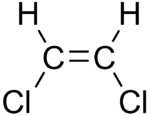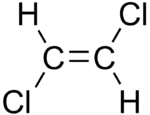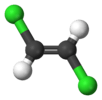1,2-Dichloroethene
| |||
| |||
| Names | |||
|---|---|---|---|
| IUPAC name
1,2-Dichloroethene | |||
| Other names
1,2-Dichloroethylene 1,2-DCE sym-Dichloroethylene | |||
| Identifiers | |||
| 156-59-2 (Z) 156-60-5 (E) 540-59-0 (mixture of E and Z) | |||
| 3D model (Jmol) | Interactive image Interactive image | ||
| ChEBI | CHEBI:18882 | ||
| ChemSpider | 10438 | ||
| ECHA InfoCard | 100.007.956 | ||
| KEGG | C06792 | ||
| PubChem | 643833 (Z) 638186 (E) 10900 (mixture of E and Z) | ||
| |||
| |||
| Properties | |||
| C2H2Cl2 | |||
| Molar mass | 96.95 g/mol | ||
| Appearance | clear liquid[1] | ||
| Odor | acrid, chloroform-like[1] | ||
| Density | Z: 1.28 g/cm³ E: 1.26 g/cm³ | ||
| Melting point | Z: -81.47 °C E: -49.44 °C | ||
| Boiling point | Z: 60.2 °C E: 48.5 °C | ||
| Z: 1.9 D E: 0 D | |||
| Hazards | |||
| Flash point | 2–4 °C; 36–39 °F; 275–277 K | ||
| Explosive limits | 5.6%-12.8%[1] | ||
| Lethal dose or concentration (LD, LC): | |||
| LD50 (median dose) |
770 mg/kg (oral, rat) 1275 mg/kg (oral, rat, trans-isomer)[2] | ||
| LC50 (median concentration) |
21,273 ppm (mouse, 6 hr, trans-isomer)[2] | ||
| LCLo (lowest published) |
16,000 ppm (rat, 6 hr, cis-isomer)[2] | ||
| US health exposure limits (NIOSH): | |||
| PEL (Permissible) |
TWA 200 ppm (790 mg/m3)[1] | ||
| REL (Recommended) |
TWA 200 ppm (790 mg/m3)[1] | ||
| IDLH (Immediate danger) |
1000 ppm[1] | ||
| Except where otherwise noted, data are given for materials in their standard state (at 25 °C [77 °F], 100 kPa). | |||
| | |||
| Infobox references | |||
1,2-Dichloroethene, commonly called 1,2-dichloroethylene or 1,2-DCE, is an organochloride with the molecular formula C2H2Cl2. It is a highly flammable, colorless liquid with a sharp, harsh odor. It can exist as either of two geometric isomers, cis-1,2-dichloroethene or trans-1,2-dichloroethene, but is often used as a mixture of the two. They have modest solubility in water. These compounds have few industrial applications,[3] although they are fundamental given their simple stoichiometries.
Production
cis-DCE, the Z isomer, is obtainable by the controlled chlorination of acetylene:
- C2H2 + Cl2 → C2H2Cl2
Industrially both isomers arise as byproduct of the production of vinyl chloride, which is produced on a vast scale. Unlike vinyl chloride, the 1,2-dichloroethylene isomers do not polymerize.[3]
trans-DCE has applications including electronics cleaning, precision cleaning, and certain metal cleaning applications.[4]
Safety
These compounds have "moderate oral toxicity to rats."[3]
See also
- 1,1-Dichloroethene
- 1,2-Dichloroethane, which is also often abbreviated as DCE
References
- 1 2 3 4 5 6 "NIOSH Pocket Guide to Chemical Hazards #0195". National Institute for Occupational Safety and Health (NIOSH).
- 1 2 3 "1,2-Dichloroethylene". Immediately Dangerous to Life and Health. National Institute for Occupational Safety and Health (NIOSH).
- 1 2 3 E.-L. Dreher; T. R. Torkelson; K. K. Beutel (2011). "Chlorethanes and Chloroethylenes". Ullmann's Encyclopedia of Industrial Chemistry. Weinheim: Wiley-VCH. doi:10.1002/14356007.o06_o01.
- ↑ http://www.axiall.com/Products/Chlorovinyls/Chlorinated-Solvents-and-Feedstock/
External links
- International Chemical Safety Card 0436
- "NIOSH Pocket Guide to Chemical Hazards #0195". National Institute for Occupational Safety and Health (NIOSH).



